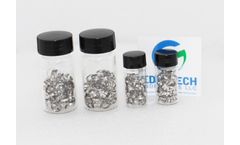Tissue Damage Articles & Analysis: Older
51 articles found
Some of the most promising applications include: Regenerative Medicine: Wharton’s jelly MSCs can potentially regenerate damaged tissues and organs due to their ability to differentiate into multiple cell types. ...
Cell therapy constitutes a form of treatment where live cells are induced into a patient's body to effectuate reconstruction or repair of damaged tissue or to enhance the body's immune system. The process could harmonize the interaction of cellular mechanisms, improve cellular function, or replace ailing cells. ...
To ensure that the targeted area is treated without damaging surrounding tissues, marker bands are used to accurately pinpoint the location of the treatment site. ...
However, dysregulation of elastase activity can lead to tissue damage and has been implicated in numerous pathological conditions. ...
One of the key advantages of nanobodies is their small size, which allows them to penetrate tissues more effectively than conventional antibodies. They also have a high degree of stability and solubility, making them suitable for various routes of administration. ...
In sepsis, a life-threatening condition characterized by systemic inflammation in response to infection, TREM1 expression is markedly upregulated, contributing to the overwhelming cytokine release and tissue damage observed in septic patients. This accentuates the potential of TREM1 as a biomarker for sepsis diagnosis and prognosis, as well as a therapeutic ...
This type of wound requires special care because diabetes can cause circulation problems and nerve damage, making it harder for the wound to heal. Clarify Wound Care Procedures To ensure effective wound care, it's crucial to adhere to the right protocols. ...
Materials Science: Protein engineering is being used to design novel biomaterials with tailored properties for tissue engineering, drug delivery, and other applications. For example, engineered proteins are being used to create scaffolds for regenerating damaged tissues and to develop nanoparticles for targeted drug delivery. ...
Serving as intermediaries, they synchronize various cell functions to elicit the body's defense mechanisms against infections, tissue restoration, and wound healing. Types of Cytokines Cytokines are classified into various families based on their structural similarities and biological functions. ...
It is important for employers to know the wind chill temperature so that they can gauge workers’ exposure risk better and plan how to safely do the work. It is also important to monitor workers’ physical condition during tasks, especially new workers who may not be used to working in the cold, or workers returning after spending some time away from work. The National Oceanic and ...
Cell therapy constitutes a form of treatment where live cells are induced into a patient's body to effectuate reconstruction or repair of damaged tissue or to enhance the body's immune system. The process could harmonize the interaction of cellular mechanisms, improve cellular function, or replace ailing cells. ...
CD73 and Adenosine Receptor Activity Promotes Immunosuppression Ecto-5′-nucleotidase (NT5E), commonly referred to as CD73, emerges as a central player in generating extracellular adenosine. When tissues face damage, inflammation, or hypoxic stress, adenosine triphosphate (ATP) is released from stressed, necrotic, or apoptotic cells. ...
Epigenetic induction plays an instrumental role in facilitating cell growth, a fundamental process vital for maintaining normal physiological functions such as tissue regeneration, wound healing, and immune responses. The process abrogates the expression of genes that inhibit cell growth and proliferation in unnecessary circumstances and modulates it when required, thereby ...
Trofinetide plays a multifaceted role in reducing inflammation, excitotoxic-induced tissue damage and apoptosis, thereby protecting neurons and their surrounding underlying tissues. 2. ...
This disturbance shifts the local microenvironment towards a pro-inflammatory state, resulting in tissue damage and the emergence of systemic immune disorders. Investigating the cellular and molecular interplay between cytokines and diseases, particularly autoimmune diseases and tumors, yields insights crucial for guiding clinical diagnosis and treatment ...
Sepsis is a severe bodily reaction to infection, which can cause fever, breathlessness, disorientation, tissue damage, and organ failure, among other symptoms. While bacterial infections are the primary culprits, any other infection such as from pneumonia or influenza may lead to sepsis if not appropriately treated. ...
They play a role in regulating immune responses, cell growth and differentiation, tissue damage, and repair, among other biological activities. Classification and function Cytokines can be classified into different groups based on their functions, including: interleukin (IL), interferon (IFN), tumor necrosis factor (TNF), colony stimulating factor (CSF), ...
Hundreds of millions of people suffer skin tissue damage every year, including accidental injury, surgical injury, chronic ulcer, etc., and severe cases may lead to amputation or even life-threatening. ...
Enzyme synthesis and secretion in normal tissues are enhanced. In the case of tissue damage, the activity of serum is increased. ...
The use of Quantitative Susceptibility Mapping (QSM) is often viewed as incompatible with current standard radiology workflows. Some radiologists or departments may be unaware of its existence or purpose. Despite the skepticism surrounding its viability in a clinical setting, QSM shows great potential in a wide range of clinical applications, particularly for biomarker detection and ...













